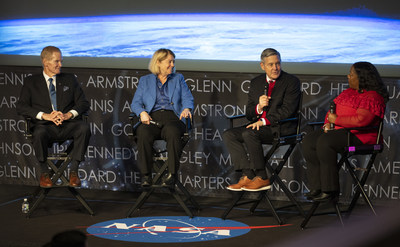WASHINGTON, Dec. 13, 2022 — (PRNewswire) — 2022 is one for the history books as NASA caps off another astronomical year.
NASA launched its mega Moon rocket for the first time, sending its uncrewed Orion spacecraft around the Moon; kicked off a new era in astronomy with the Webb Space Telescope's record-breaking new imagery from the cosmos; moved an asteroid in humanity's first ever planetary defense demonstration; working with its partners, sent astronauts on regular missions to the International Space Station, tested new technologies, including an inflatable heat shield for Mars; continued development of quieter supersonic aircraft, and much more.
"There is no doubt that 2022 was out of this world! From the history-making splashdown of the Artemis I mission, to the groundbreaking images from NASA's James Webb Space Telescope to the innovative LOFTID technology demonstration, the smashing success of the DART mission, incredible progress in our aeronautics programs, and the growth of partnerships with commercial and international partners, 2022 will go down in the history books as one of the most accomplished years across all of NASA's missions," said NASA Administrator Bill Nelson. "There's so much to look forward to in 2023 too: More stunning discoveries from Webb telescope, climate missions that will tell us more about how our Earth is changing, continued science on the International Space Station, groundbreaking aeronautics developments with the X-59 and X-57 experimental aircraft, the selection of the first astronauts to go to the Moon in more than 50 years, and more. Space is the place and NASA proves humanity's reach is limitless!"
In support of the Biden-Harris Administration's priorities, the agency remained a global leader in providing data related to climate change including unveiling a concept for a new Earth Information Center, and published NASA's first Equity Action Plan. Congress also passed, for the first time in five years, a NASA Authorization Act. And in 2022, NASA reached a decade of excellence by being named as the Best Place to Work in the federal government among large agencies by the Partnership for Public Service for an unprecedented 10th consecutive time.
Below is a summary of accomplishments, demonstrating how in 2022, NASA explored the unknown in air and space, innovated for the benefit of humanity, and inspired the world through discovery.
Preparing for human lunar exploration
Among the accomplishments for NASA's human spaceflight programs, the agency
successfully launched, for the first time, its Space Launch System (SLS) rocket, which put NASA's Orion spacecraft on a path that traveled farther than any spacecraft built for astronauts has been before. Through Artemis, the agency advanced plans to send the first woman and first of color to the Moon. Leading up to the historic Nov. 16 launch of Artemis I, as well as a successful Orion splashdown on Dec. 11, NASA completed multiple key milestones for SLS, Orion, and ground systems:
- Worked to assemble the rocket's core stage at the agency's Michoud Assembly Facility in New Orleans and the crew module at Kennedy, selected the vehicle that will transport astronauts to the launch pad, and qualified the final launch abort system engine for the Artemis II mission, the first flight with crew.
- Completed manufacturing the booster segments and delivered the engine section to Kennedy for the Artemis III mission, which will be humanity's first return to the lunar surface in more than 50 years and land the first woman on the Moon.
- Fired a ground-based version of a booster in Promontory, Utah, for future missions, completed the critical design review for the more powerful evolved configuration of the SLS rocket, known as Block 1B, and began moving toward a services contract model for long-term SLS hardware production and operations to reduce costs.
The agency also completed numerous key Artemis milestones that will ensure not only a human return to the lunar surface, but long-term exploration on and around the Moon in preparation for sending the first astronauts to Mars:
- Identified 13 candidate landing regions near the lunar South Pole where the next American astronauts on the Moon could land during Artemis III, selected Axiom Space to provide the moonwalking system, including spacesuits, that astronauts will use during Artemis III, as well as awarded a task order to Collins Aerospace to develop new spacesuits for the International Space Station.
- Awarded a contract modification to SpaceX to further develop its Starship human landing system to meet agency requirements for long-term human exploration of the Moon, including a second crewed landing demonstration mission during Artemis IV, and announced a call to companies to provide proposals for sustainable lunar lander development as the agency works toward a regular cadence of Moon landings beyond Artemis IV.
- Issued a draft request for proposals for Lunar Terrain Vehicle services to solicit companies' feedback and completed desert analog mission with crew in a simulated lunar environment to test pressurized rover operations and moonwalks for future Artemis missions.
- Built on past international partnerships for long-term exploration at the Moon with Japan and South Africa, as well as added new signatories through the Artemis Accords with Bahrain, Colombia, Israel, Nigeria, Romania, Rwanda, and Singapore.
- Released a revised set of Moon to Mars Objectives, forming a blueprint for shaping human exploration throughout the solar system.
- Researchers from the University of Florida grew Arabidopsis thaliana plants in lunar soil gathered during Apollo missions, showing that plants have the potential to grow on the Moon.
Maintaining human presence in low-Earth orbit
The NASA Authorization Act passed by Congress extended America's participation in the International Space Station through at least Sept. 30, 2030, enabling the U.S. to continue to reap the benefits for the next decade while the agency works with American industry to develop commercial destinations and markets for a thriving space economy. This was the 22nd continuous year of human presence aboard the orbiting laboratory. Here are some accomplishments in 2022:









